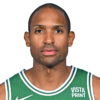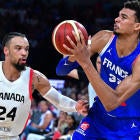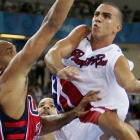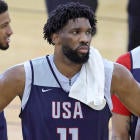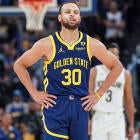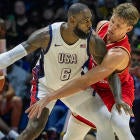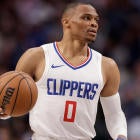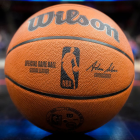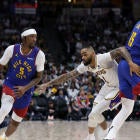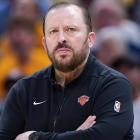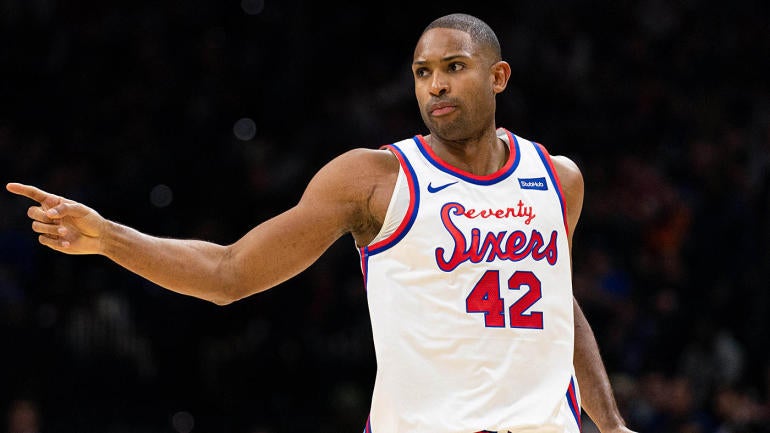
Al Horford trade rumors were, by Philadephia 76ers standards, long overdue. This is a roster that has already undergone three dramatic transformations since the beginning of the 2018-19 season. Elton Brand is not a patient GM. Horford, in the first season of a massive four-year deal in which he is vastly underperforming, is the most obvious scapegoat for Philadelphia's disappointing season. It was only a matter of time before his name was going to find its way into the rumor mill.
And sure enough, those rumors arrived Saturday, via Jeff Zillgitt of USA Today. The goal, according to Zillgitt's report, would be to exchange Horford for shooting. The approach makes sense. Philadelphia is currently ranked 23rd in the NBA in 3-point attempts per game and 17th in percentage. They will likely regress in both areas in a playoff setting that sees some of the bench minutes dedicated to floor spacers like Furkan Korkmaz and Shake Milton to superstars Joel Embiid and Ben Simmons. Shooting is far and away their greatest need.
But trading Horford to fill that need this offseason won't be easy. He is already 33 years old and is owed $69 million guaranteed for the next three seasons (or $81.5 million if the non-guaranteed portion of his final season is kept rather than waived). His numbers have declined across the board. Very few teams are in a position to take on his deal.
The key, then, will be finding potential trade partners that have similarly toxic contracts on their books. A few such teams exist, and have the shooting Philadelphia craves in any deal. Five teams stand out as possible Horford destinations, so let's go through each of them and try to create a sensible trade.
1. Cleveland Cavaliers
- Cleveland receives: Al Horford, 2022 second-round pick, 2023 second-round pick (most favorable of Atlanta, Charlotte and Brooklyn)
- Philadelphia receives: Kevin Love
This is the easiest trade on the board. Cleveland and Philadelphia merely swap their disgruntled big men. Cleveland, currently holding the slightly more valuable of the two and needing to save face on the Love contract it signed ostensibly to trade, gets two second-round picks in the process.
If any team in the NBA is equipped to hide Love's weaknesses, it is Philadelphia. Not even Love could screw up defensive lineups featuring Joel Embiid, Ben Simmons and Matisse Thybulle. He knows how to space the floor on a contender having done it for LeBron James for four seasons. His outlet passing alongside Simmons would create one of the best transition attacks in the NBA. Swapping Horford for Love only boosts what is already the sixth-best rebounding team in the NBA.
In Horford, Cleveland at least gets a center who makes more sense on a rebuilding roster than Love does. His defense, half-court passing and screening should be nice developmental boosters for a team filled with young guards. Boston's young players thrived alongside Horford. Ideally, he'd have the same effect in Cleveland. Even if he doesn't, getting two second-round picks in what is essentially a dead money swap for their purposes, including one that should be quite valuable, is a nice bit of a contractual arbitrage.
2. Washington Wizards
- Washington receives: Al Horford, Mike Scott
- Philadelphia receives: John Wall, Moritz Wagner
Here's where things get slightly more complicated. Wall has one of the few contracts in basketball worse than Horford's. In making this swap, Washington would be saving approximately $63.6 million in guaranteed or functionally guaranteed money.
The 76ers would essentially take on that extra money to get two cost-controlled seasons of Wagner, who, before his mid-season ankle injury, was shooting nearly 40 percent from behind the arc and was averaging 18.8 points and 10.1 rebounds per 36 minutes. His numbers have since regressed, though whether that was due to injury or skill cannot be said. Anything Wall would provide in this scenario is likely a bonus, though for what it's worth, at his peak he was arguably the best generator of 3-point attempts for teammates in the NBA. His own shooting leaves much to be desired, but in the right setting, Wall is a spacing booster.
The Wizards, who nearly signed Horford in 2016, would benefit from his versatile skill set during a rebuild in the same way Cleveland would. They would also rid themselves of Wall ahead of a point guard-heavy 2020 NBA Draft class in which they will likely hold a lottery pick.
Philadelphia would likely demand more to take on so much money. In the past, taking on approximately $20 million in dead salary has been worth a first-round pick through trade. The rising cap should impact that figure, but Wagner himself is not worth two or three picks. But if Philadelphia values Wall at all, could convince Washington to part with another desirable asset or was even willing to surrender enough extra salary to potentially make a Davis Bertans sign-and-trade work, the basic framework of a Horford-for-Wall-and-shooting trade exists so long as the 76ers are willing to take on the money.
3. Golden State Warriors
- Golden State receives: Al Horford, 2021 second-round pick
- Philadelphia receives: Andrew Wiggins, Damion Lee, Jordan Poole
Once upon a time, Horford was considered the Eastern Conference's answer to Draymond Green. Even in his compromised state, the idea of pairing the two of them defensively should give the Western Conference nightmares. Few teams have the front-court personnel to switch everything, but a Horford-Green pairing would allow the Warriors to do so with ease. Horford's passing would be more than welcome in Steve Kerr's motion offense. Aside from the 2015-16 Green blip, Golden State has never had a center with any sort of shooting ability. Imagine giving the Splash Brothers even more space to work with.
Fitting another expensive inconsistent shooter into their rotation would hardly be ideal for Philadelphia, but unlike Wall, Wiggins wouldn't exactly be dead money. Even if his strong shooting numbers in Golden State don't carry over to Philly, he is, if nothing else, a high-level bench contributor. He is also Embiid's former college teammate. Perhaps that unlocks his explosive defensive potential. Neither Lee nor Poole are sure things, but both have shooting upside. Lee is making nearly 39 percent of his wide-open attempts this season. Poole is struggling in the NBA, but shot 37 percent from behind the arc in college. Clearing two rosters spots has value for Golden State considering its desirability as a free agency destination.
If Wiggins continues to play as well for Golden State as he has, this deal is off the table. He has to regress to the mean for Golden State to even consider swapping a 25-year-old former No. 1 overall pick for a 33-year-old center. Horford makes more sense for their 2020-21 plans than Wiggins does, but if he can be fully rehabilitated, Wiggins' long-term potential is significantly more valuable.
4. Detroit Pistons
- Detroit receives: Al Horford, Mike Scott, 2022 first-round pick (top-10 protected), 2020 second-round pick (via Atlanta), 2021 second-round pick (via New York)
- Philadelphia receives: Blake Griffin, Luke Kennard
Kennard was almost traded for a first-round pick from the Phoenix Suns at the trade deadline before a disagreement over the pick's protection sunk the deal. In a sense, this is merely an expansion of that sort of trade. The Pistons get a first-round pick for Kennard along with two very valuable second-rounders. In exchange, they make the Horford-for-Griffin swap, taking on an extra year of money in the process (either $14.5 million in dead money or $26.5 million with him on the roster). Not a bad haul for a team looking to kickstart a rebuild.
Griffin makes almost no sense on Philadelphia's roster, but hey, if he's healthy, finding minutes for a former All-Star is hardly ever a bad thing. Kennard is the true gem of the deal. He was in the midst of a breakout season for Detroit before getting injured in December, averaging nearly 16 points on 39.9 percent shooting from behind the arc. He could be Philadelphia's long-term JJ Redick replacement provided he stays healthy, which is sadly never a given for the 76ers.
5. Sacramento Kings
- Sacramento receives: Al Horford, 2022 first-round pick (top-10 protected), 2020 second-round pick (via Atlanta), 2021 second-round pick (via New York)
- Philadelphia receives: Harrison Barnes, Nemanja Bjelica
This is the hardest sell of the five. Sacramento gets the same package as Detroit, but rather than trading a broken-down Griffin, gives up a still-useful Barnes alongside Bjelica, who is shooting 44 percent from behind the arc this season. In all likelihood, the Kings pass on this, but there's enough of an argument here to at least draw a mention.
The Kings have something of a logjam in the frontcourt. Finding minutes for Barnes, Bjelica, Marvin Bagley, Richaun Holmes and Harry Giles next season is going to be difficult even with Barnes likely playing more minutes at small forward. Swapping two of them out for Horford, who will need fewer minutes as he ages and has the most diverse skill set of that group, makes some sense. His defensive versatility pairs well with the offensively-driven Bagley and Holmes, who functions most comfortably as a rim-protector defensively.
The deal would also save the Kings a bit of money next season, which could only help in their efforts to retain Bogdan Bogdanovic, and the absence of Barnes could push the Kings to finally start Bogdanovic, Buddy Hield and De'Aaron Fox together in a three-guard alignment. Such a group would have obvious defensive deficiencies, but would at least allow the Kings to see how their three best players fit together over a reasonable amount of time.
Don't count on this deal, but Sacramento could justify it, and the 76ers would take it in a heartbeat. They almost signed Bjelica in 2018 before he backed out of their agreement to join the Kings, and Barnes is a valuable 3-and-D role player. To get both for Horford, whom they don't exactly seem eager to keep right now, would be an absolute coup.



